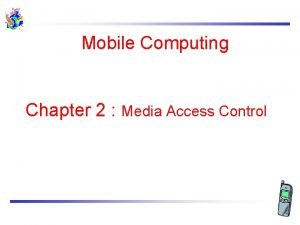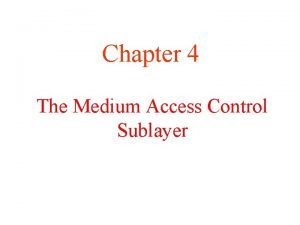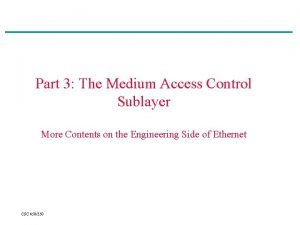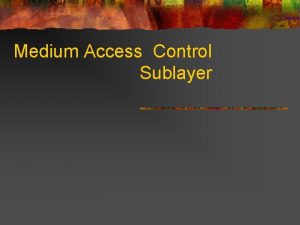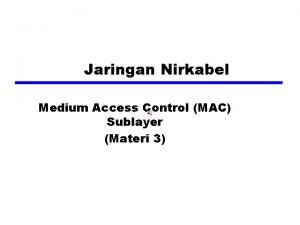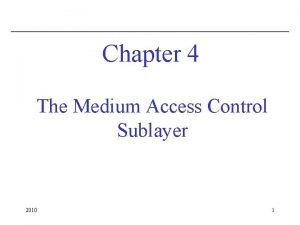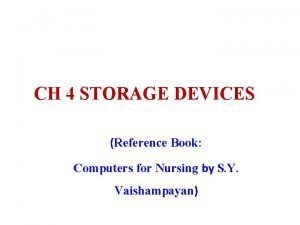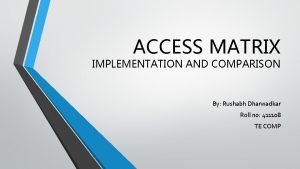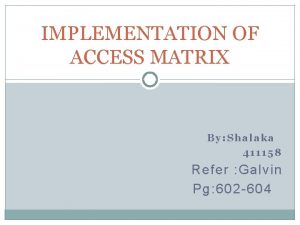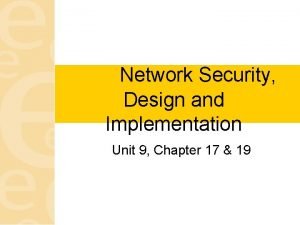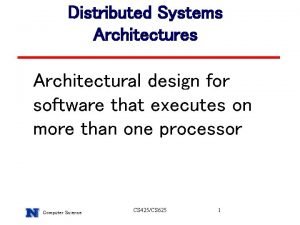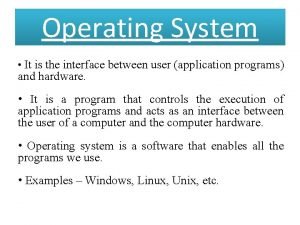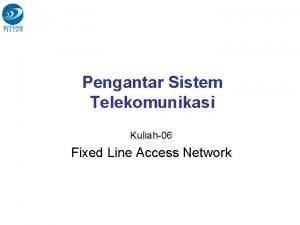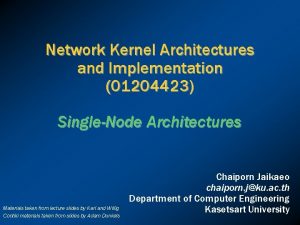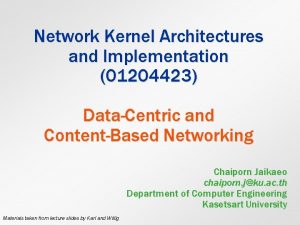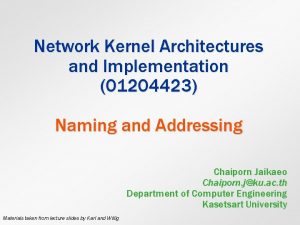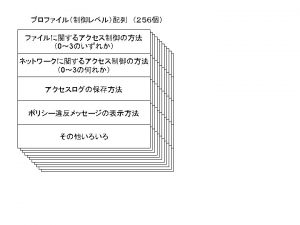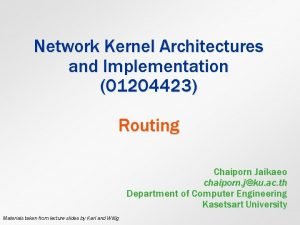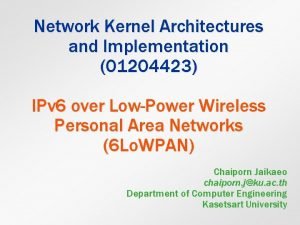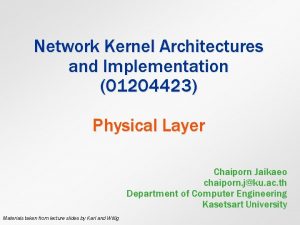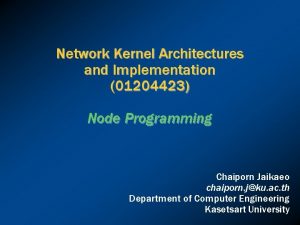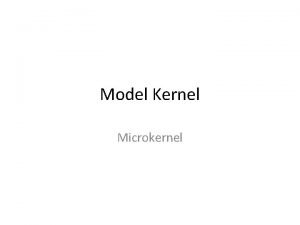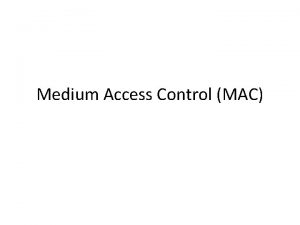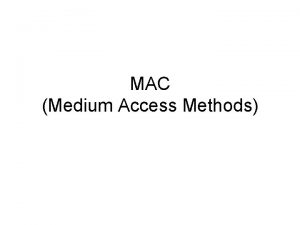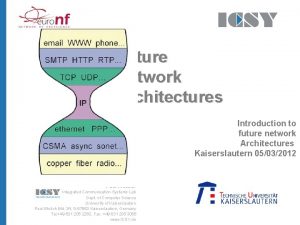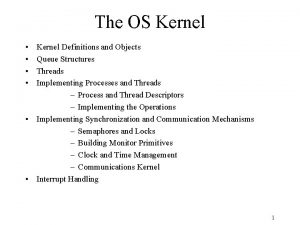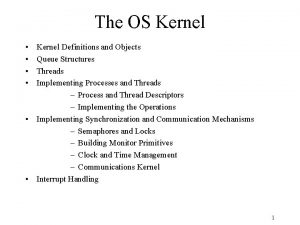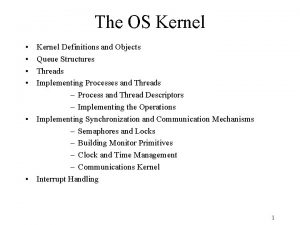Network Kernel Architectures and Implementation 01204423 Medium Access











































- Slides: 43

Network Kernel Architectures and Implementation (01204423) ) Medium Access Control and WPAN Technologies Chaiporn Jaikaeo chaiporn. j@ku. ac. th Department of Computer Engineering Kasetsart University Materials taken from lecture slides by Karl and Willig

Overview l l Principal options and difficulties Contention-based protocols Schedule-based protocols Wireless Personal Area Networks Technologies 2

Difficulties l Medium access in wireless networks is difficult, mainly because of Ø Ø l Half-duplex communication High error rates Requirements Ø Ø As usual: high throughput, low overhead, low error rates, … Additionally: energy-efficient, handle switched off devices! 3

Requirements for Energy-Efficient MAC Protocols l Recall Ø Ø Ø l Energy problems Ø Ø l Transmissions are costly Receiving about as expensive as transmitting Idling can be cheaper but is still expensive Collisions Overhearing Idle listening Protocol overhead Always wanted: Low complexity solution 4

Main Options Wireless medium access Centralized Schedulebased Fixed assignment Demand assignment Contentionbased Distributed Schedulebased Fixed assignment Contentionbased Demand assignment 5

Centralized Medium Access l A central station controls when a node may access the medium Ø Ø l l l E. g. , Polling, computing TDMA schedules Advantage: Simple, efficient Not directly feasible for non-trivial wireless network sizes But: Can be quite useful when network is somehow divided into smaller groups Distributed approach still preferable 6

Schedule- vs. Contention-Based l Schedule-based protocols Ø Ø FDMA, TDMA, CDMA Schedule can be fixed or computed on demand § Ø Ø l Usually mixed Collisions, overhearing, idle listening no issues Time synchronization needed Contention-based protocols Ø Ø Ø Hope: coordination overhead can be saved Mechanisms to handle/reduce probability/impact of collisions required Randomization used somehow 7

Overview l l Principal options and difficulties Contention-based protocols Schedule-based protocols Wireless Personal Area Networks Technologies 8

Distributed, Contention-Based MAC l Basic ideas Ø Ø Receivers need to tell surrounding nodes to shut up Listen before talk (CSMA) § Suffers from sender not knowing what is going on at receiver Hidden terminal scenario: A B C D Also: recall exposed terminal scenario 9

How To Shut Up Senders l Inform potential interferers during reception Ø Ø Cannot use the same channel So use a different one § l Busy tone protocol Inform potential interferers before reception Ø Ø Ø Can use same channel Receiver itself needs to be informed, by sender, about impending transmission Potential interferers need to be aware of such information, need to store it 10

MACA l l l Multiple Access with Collision Avoidance Sender B issues Request to Send (RTS) Receiver C agrees with Clear to Send (CTS) Potential interferers learns from RTS/CTS B sends, C acks Used in IEEE 802. 11 11

Virtual Carrier Sensing A B C D RTS CTS NAV Data NAV ACK NAV Network Allocation Vector (Virtual Carrier Sensing) 12

Problems Solved? l RTS/CTS helps, but do not solve hidden/exposed terminal problems 13

MACA Problem: Idle listening l Need to sense carrier for RTS or CTS packets Ø l Simple sleeping will break the protocol IEEE 802. 11 solution Ø Ø Ø Idea: Nodes that have data buffered for receivers send traffic indicators at prearranged points in time ATIM - Announcement Traffic Indication Message Receivers need to wake up at these points, but can sleep otherwise 14

Sensor-MAC (S-MAC) l MACA unsuitable if average data rate is low Ø l Most of the time, nothing happens Idea: Switch off, ensure that neighboring nodes turn on simultaneously to allow packet exchange Ø Ø Need to also exchange wakeup schedule between neighbors When awake, perform RTS/CTS 15

Schedule Assignment l Ø Listen A Go to sleep after time t Listen for SYNC Synchronizer Sleep Ø Ø Broadcasts l B td Broadcasts Go to sleep after time t- td Follower Ø Listen Sleep Listen for a mount of time If hear no SYNC, select its own SYNC Broadcasts its SYNC immediately Ø Ø Listen for amount of time Hear SYNC from A, follow A’s SYNC Rebroadcasts SYNC after random delay td 16

S-MAC Synchronized Islands l l Nodes learn schedule from other nodes Some node might learn about two different schedules from different nodes Ø l “Synchronized islands” To bridge this gap, it has to follow both schemes A A B B E C C E D E E C C C D D D E Time 17

Preamble Sampling l Alternative option: Don’t try to explicitly synchronize nodes Ø l Have receiver sleep and only periodically sample the channel Use long preambles to ensure that receiver stays awake to catch actual packet Ø Example: B-MAC, Wise. MAC Start transmission: Check channel Long preamble Actual packet Check channel Stay awake! Check channel 18

B-MAC l l Very simple MAC protocol Employs Ø Ø Ø Clear Channel Assessment (CCA) and backoffs for channel arbitration Link-layer acknowledgement for reliability Low-power listening (LPL) § l I. e. , preamble sampling Currently: Often considered as the default WSN MAC protocol 19

B-MAC l B-MAC does not have Ø Ø Synchronization RTS/CTS Results in simpler, leaner implementation Clean and simple interface 20

Clear Channel Assessment l "Carrier Sensing" in wireless networks Thresholding CCA algorithm Outlier detection CCA algorithm 21

Contiki LPL and LPP l Low-Power Listening (LPL) Ø Ø l Also known as Contiki. MAC Similar to B-MAC, but allowing packet-based MAC such as IEEE 802. 15. 4 Low-Power Probing (LPP) Ø Ø Receivers periodically broadcast a probe Sender listens for probes from receivers before transmitting 22

Overview l l Principal options and difficulties Contention-based protocols Schedule-based protocols Wireless Personal Area Networks Technologies 23

LEACH l l Low-Energy Adaptive Clustering Hierarchy Assumptions Ø Ø Ø l Dense network of nodes Direct communication with central sink Time synchronization Idea: Group nodes into “clusters” Ø Ø Ø Each cluster controlled by clusterhead About 5% of nodes become clusterhead (depends on scenario) Role of clusterhead is rotated 24

LEACH Clusterhead l Each CH organizes Ø Ø l CDMA code for its cluster TDMA schedule to be used within a cluster In steady state operation Ø Ø CHs collect & aggregate data from all cluster members Report aggregated data to sink using CDMA 25

LEACH rounds 26

TRAMA l l l Traffic Adaptive Medium Access Protocol Assume nodes are time synchronized Time divided into cycles, divided into Ø Ø Random access period Scheduled access period time cycle Random Access Period • Exchange and learn two-hop neighbors • Exchange schedules Scheduled-Access Period • Used by winning nodes to transmit data 27

TRAMA – Adaptive Election l How to decide which slot (in scheduled access period) a node can use? Ø For node id x and time slot t, compute p = h (x t) § Ø Ø h is a global hash function Compute p for next k time slots for itself and all twohop neighbors Node uses those time slots for which it has the highest priority A B C t=0 t=1 t=2 14 23 9 33 64 8 53 18 6 t=3 56 12 33 t=4 t=5 3 26 44 6 57 2 28

Overview l l Principal options and difficulties Contention-based protocols Schedule-based protocols Wireless Personal Area Networks Technologies 29

IEEE 802. 15. 4 l IEEE standard for low-rate WPAN (LR-WPAN) applications Ø Ø Ø l Physical layer Ø Ø Ø l Low-to-medium bit rates Moderate delays without too strict requirements Low energy consumption 20 kbps over 1 channel @ 868 -868. 6 MHz 40 kbps over 10 channels @ 905 – 928 MHz 250 kbps over 16 channels @ 2. 4 GHz MAC protocol Ø Ø Ø Single channel at any one time Combines contention-based and schedule-based schemes Asymmetric: nodes can assume different roles 30

802. 15. 4 PHY Overview l Operating frequency bands 868 MHz / 915 MHz PHY 2. 4 GHz Channel 0 Channels 1 -10 868. 3 MHz 902 MHz Channels 11 -26 2 MHz 928 MHz 5 MHz 2. 4835 GHz 31

802. 15. 4 Device Classes l Full function device (FFD) § § § l Any topology Network coordinator capable Talks to any other device Reduced function device (RFD) § § Limited to star topology Cannot become a network coordinator Talks only to a network coordinator Very simplementation 32

802. 15. 4 Network Topologies 33

802. 15. 4 Beaconed Mode l Superframe structure l GTS assigned to devices upon request 34

802. 15. 4 GTS Data Transfer l Device coordinator Ø Ø If having allocated GTS, wake up and send Otherwise, send during CAP § l Using slotted CSMA Coordinator device Ø Ø If having allocated GTS, wake up and receive Otherwise, see picture

IEEE 802. 15. 4 Adopters l Zig. Bee Ø Ø Ø l Requires battery life of at least two years be certified Applications: Industrial control, embedded sensing, home automation Zig. Bee RF 4 CE (Radio Frequency for Consumer Electronics) Nest (acquired by Google) Ø Ø Learning thermostats, Smoke and CO alarms Wi. Fi- and Zig. Bee-enabled https: //nest. com 36

Bluetooth Smart l Formally Bluetooth Low Energy (BLE) Ø l l Part of Bluetooth 4. 0 Specification Based on Nokia's Wibree technology First smartphones to support i. Phone 4 S Ø Now supported by most recent smartphones http: //redbearlab. com/blenano/ 37

Bluetooth: Classic vs. Smart Source: Bluetooth SIG 38

Bluetooth Compatibility http: //blog. laptopmag. com/just-what-is-bluetooth-4 -0 -anyway 39

Bluetooth Smart: Device Roles l Central device Ø Ø Ø l Serves as a hub to one or more peripheral devices Two central devices cannot directly communicate Similar to IEEE 802. 15. 4's FFD Peripheral device Ø Ø Ø Must be connected to a central device Two peripheral devices cannot directly communicate Similar to IEEE 802. 15. 4's RFD 40

ANT / ANT+ / NIKE+ l l Primarily used for fitness monitoring devices ANT / ANT+ Ø l open access multicast wireless sensor network NIKE+ Ø Nike. com Proprietary protocols on 2. 4 GHz band http: //developer. sonymobile. com 41

Wi. Fi/Zig. Bee/Bluetooth Coexistence l They all employ 2. 4 GHz spectrum Wi. Fi vs. Zigbee Wi. Fi vs. Bluetooth http: //www. digikey. com/en/articles/techzone/2011/aug/comparing-low-power-wireless-technologies 42

Summary l l l Many different ideas exist for medium access control in MANET/WSN Comparing their performance and suitability is difficult Especially, clearly identifying interdependencies between MAC protocol and other layers/applications is difficult Ø l Which is the best MAC for which application? Nonetheless, certain “common use cases” exist Ø Ø Ø IEEE 802. 11 DCF for MANET IEEE 802. 15. 4 for some early “commercial” WSN variants B-MAC for WSN research not focusing on MAC 43
 Switched backbone networks
Switched backbone networks Backbone network architectures
Backbone network architectures Hot and cool media
Hot and cool media Medium medium 35m newton
Medium medium 35m newton Kernel network
Kernel network Database and storage architectures
Database and storage architectures Autoencoders, unsupervised learning, and deep architectures
Autoencoders, unsupervised learning, and deep architectures Classical aloha in mobile computing
Classical aloha in mobile computing Medium access sub layer
Medium access sub layer Medium access sublayer
Medium access sublayer The medium access control sublayer
The medium access control sublayer Medium access sublayer
Medium access sublayer Channel allocation problem in medium access sublayer
Channel allocation problem in medium access sublayer Medium access sublayer adalah
Medium access sublayer adalah Media access control sublayer
Media access control sublayer Book
Book Access matrix in os
Access matrix in os Implementation of access matrix
Implementation of access matrix Network security design and implementation
Network security design and implementation Modular product architectures
Modular product architectures Ansi/sparc
Ansi/sparc Scalable internet architectures
Scalable internet architectures Product architecture design
Product architecture design Gui architectures
Gui architectures Database system architectures
Database system architectures Cdn architectures
Cdn architectures Scalable web architectures
Scalable web architectures How many tier data warehouse architecture?
How many tier data warehouse architecture? Types of instruction sets
Types of instruction sets Browser/server architecture
Browser/server architecture Distributed systems architectures
Distributed systems architectures Cache coherence for gpu architectures
Cache coherence for gpu architectures Why systolic architectures
Why systolic architectures Pathcords
Pathcords Terminal access controller access-control system
Terminal access controller access-control system Terminal access controller access-control system
Terminal access controller access-control system Plug and play manager in kernel
Plug and play manager in kernel Interface between user and hardware
Interface between user and hardware Provides uniform interface between controller and kernel
Provides uniform interface between controller and kernel Juniper network access control
Juniper network access control Access network adalah
Access network adalah Network access quarantine control
Network access quarantine control Health access network
Health access network Simultaneous access in network
Simultaneous access in network







